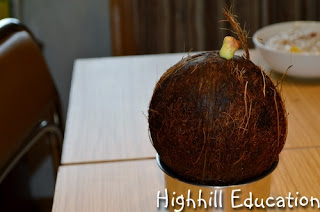Plants can be grown from seed, but many can be grown from other plant parts as well. Temperature, moisture and amount of light needs to be just right for sprouting to occur. Each type of plant is unique. Experimenting with plants can be interesting, educational and enjoying.
Here are some unique plant experiments to try.
Sprouting a Coconut
A coconut is a very large seed. There are at least two ways to get a coconut seed to sprout. One is to place the coconut in a bucket of warm water with a weight on top of the coconut to keep it submerged. The other is to place the coconut into a plastic bag with a small amount of water inside.
My son chose the plastic bag method. Patience is the key. Coconuts usually sprout in one month, but can take up to nine months. The white dot is the sprout as it emerges from the coconut.
Here it is again one month later.
Growing a Tomato Plant from Suckers
Suckers are branches on a tomato plant that grow at a junction after another branch has grown which contains flowers. Suckers take away energy from the growing tomatoes and cause the plant to get bigger. Many tomato growers break off the suckers.
Once the sucker is broken off, it can grow into a separate plant. Place the branch in water and wait for roots to sprout, then bury the roots in the ground.
Growing Celery
Did you know celery will grow from the bottom of the stalk? Take the part that is normally discarded and place it in water. After a week or two new celery should start to grow up from the base. Following the growth of the top, roots should begin to show. Once the roots show, place the plant in the ground.
Growing Pineapple
A pineapple plant can be grown from the leaves at the top of an existing pineapple.
Trim off the pineapple and place the leaves with a little bit of flesh into water and wait for roots to sprout. This is another plant that requires patience as it can take four years for a pineapple plant to produce a pineapple.

Our other plant and science activities can be found on our Science Page.









No comments:
Post a Comment
Note: Only a member of this blog may post a comment.